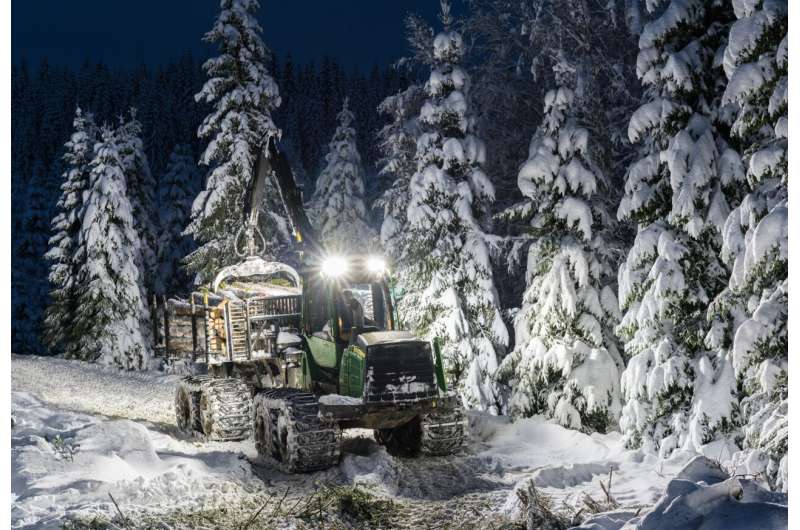This article has been reviewed according to Science X's editorial process and policies. Editors have highlighted the following attributes while ensuring the content's credibility:
fact-checked
proofread
What motivates forest owners to engage in early harvesting?

Data from Norway's National Forest Inventory and from the forest authorities' quality monitoring regime show that over 25% of the forests in Norway are harvested before reaching maturity class 5, the development stage where the forests are normally considered ready for the final harvest.
The extent of such early harvesting is particularly high in stands dominated by Norway spruce trees, with a high site productivity index, and along the coast in Western Norway.
"If healthy forests are harvested before reaching maturity, this will result in reduced timber production and a lower carbon uptake from those areas," says Research Scientist Helmer Belbo at NIBIO's office in Steinkjer, in Central Norway.
To investigate the motives behind why forest owners still choose to harvest their forests earlier than what is considered optimal, Belbo and his colleague at NIBIO, Aksel Granhus, contacted forest owners, forest managers, and timber buyers from all over Norway.
In total, 1,254 forest owners, 112 timber buyers, and 146 forestry managers participated in the survey.
Timber price is crucial for choosing a time to harvest
The results show that 28% of the final felling area was in the maturity class 3 or 4, while nearly three-quarters (72%) were in the maturity class 5. Timber buyers and forest managers, on their side, estimated that 24 and 32% of the timber volume in their respective areas was cut in forests younger than maturity class 5.
"Early final harvests are often motivated by forest health problems, changes in land use, and neighbors harvesting. The latter is simply that the forest owner gets the felling done because the logging team is available in that area," Belbo explains.
Most of the early harvests are for new agricultural areas in Central and Northern Norway
The percentage of forest owners wanting to reassign all, or parts, of their harvested area for agricultural purposes was 6% in Eastern Norway 12% in Southern Norway, and 19-24% in Western Norway and northward.
"In contrast, when the final harvest was done at an earlier stage, reassignment was the motive in as much as half of the cases in Trøndelag and in Northern Norway," Belbo says.
In the rest of the country, there was little difference between early and regular harvesting times.
The forest managers indicated that as much as 45% of the harvested forest area in maturity class 3 and 20% of the harvested forest area in maturity class 4 are reassigned—primarily for agricultural purposes. There was also a clear difference in the justification for logging between those who exclusively felled forests in maturity class 5 and those who also felled younger forests in the same logging operation.
"In the first group, good operational conditions, timber prices, and the fact that the forest was due for felling in their forest management plan were the most important motivations for harvesting," says Belbo.
For those forest owners who had harvested their forest at an earlier stage, the recommendations in the forest plan were (naturally) less emphasized. The same applied to operational conditions and, to some extent, timber prices. Additionally, very few forest owners mentioned a desire to change tree species composition or acute financial needs as a motive for harvesting.
More than half of the forest owners surveyed had consulted with others prior to the decision to harvest. The group most frequently consulted was the timber buyers, as also indicated by the responses from municipal forest managers. However, timber buyers themselves downplay their role and importance in the forest owner's decision to harvest or not.
"Since the forest owner is often motivated by either forest health challenges or a desire to make a sound economic decision, good forestry decision support will contribute to good decisions," Belbo says.
Loss calculator available
The timing of harvesting has significant consequences for both the forest owner's economy, national timber production, and carbon capture. The forestry extension service Skogkurs has therefore developed a guide, "Early Harvest—Consequences of Choosing Logging Age" (in Norwegian), and a separate calculator that helps the forest owner estimate how much they lose by harvesting the stand 5-20 years before the normal maturity age.
"The loss calculator is a valuable tool, both for forest owners and forest managers, when it comes to assessing the economic consequences of different harvesting times," says Belbo.
A challenge for both forest owners and their advisors is that the loss calculator assumes that the forest follows normal development.
"However, there are no decision support tools to rely on in order to assess whether forest health challenges in standing forests younger than maturity class 5 justify early logging or not," Belbo says.
In other words, the forest owner is then at the mercy of their own, or at their advisor's, judgment when determining whether the forest should be harvested or allowed to continue growing.
"Even though the advisor has significant training and expertise, such assessments are often quite challenging. Better tools will most likely provide a better basis for determining whether an early harvest is a good management measure or not, in the cases where early harvests are done," Belbo concludes.
Provided by Norwegian Institute of Bioeconomy Research



















